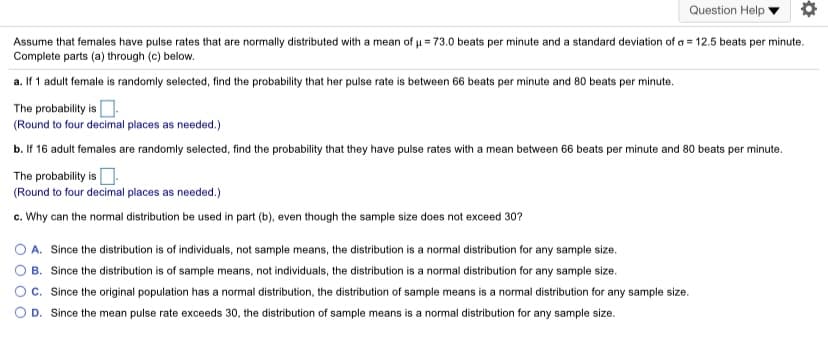Question Help Assume that females have pulse rates that are normally distributed with a mean of u = 73.0 beats per minute and a standard deviation of a = 12.5 beats per minute. Complete parts (a) through (c) below. a. If 1 adult female is randomly selected, find the probability that her pulse rate is between 66 beats per minute and 80 beats per minute. The probability is . (Round to four decimal places as needed.) b. If 16 adult females are randomly selected, find the probability that they have pulse rates with a mean between 66 beats per minute and 80 beats per minute. The probability is . (Round to four decimal places as needed.) c. Why can the normal distribution be used in part (b), even though the sample size does not exceed 30? A. Since the distribution is of individuals, not sample means, the distribution is a normal distribution for any sample size. O B. Since the distribution is of sample means, not individuals, the distribution is a normal distribution for any sample size. c. Since the original population has a normal distribution, the distribution of sample means is a normal distribution for any sample size. D. Since the mean pulse rate exceeds 30, the distribution of sample means is a normal distribution for any sample size. O O
Continuous Probability Distributions
Probability distributions are of two types, which are continuous probability distributions and discrete probability distributions. A continuous probability distribution contains an infinite number of values. For example, if time is infinite: you could count from 0 to a trillion seconds, billion seconds, so on indefinitely. A discrete probability distribution consists of only a countable set of possible values.
Normal Distribution
Suppose we had to design a bathroom weighing scale, how would we decide what should be the range of the weighing machine? Would we take the highest recorded human weight in history and use that as the upper limit for our weighing scale? This may not be a great idea as the sensitivity of the scale would get reduced if the range is too large. At the same time, if we keep the upper limit too low, it may not be usable for a large percentage of the population!

Trending now
This is a popular solution!
Step by step
Solved in 2 steps with 2 images









